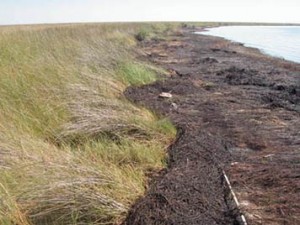
After the 2010 Deepwater Horizon spill, a heavy layer of oiled vegetation mats were preventing the thick emulsified oil underneath from breaking down along Barataria Bay’s marshes. (NOAA/Scott Zengel)
Coastal wetland vegetation is essential to the coastal area because it provides a barrier for the local community, a nursery habitat for juvenile organisms, and a highly productive environment for the marine life. This form of vegetation has a very high potential to come in contact with pollution, originating from inshore or offshore sources, because it is in areas usually separating ocean from land.
The most recent and notable offshore drilling incident was the BP Deepwater Horizon oil spill which was responsible for releasing millions of barrels of oil into the Gulf of Mexico and the surrounding coast. There are different types of oils and each has varying degrees of physical harm for proximal vegetation and soil, inducing and/or intensifying coastal erosion. The pollutant decays the root area of plants, creating a looser soil with a weaker support system.
This is a symbolic experiment for coastal wetland vegetation that may come in contact with light crude oil contamination (vegetable oil), heavier crude oil contamination (motor oil), or crude oil contamination in hypersaline environments. Light crude oil should be less harmful to wetlands in comparison to a heavier crude oil (more metal content) or even light crude oil in hypersaline areas (high salt content may absorb more water and nutrients from the plants, allowing for further smothering of the vegetation by oil).
